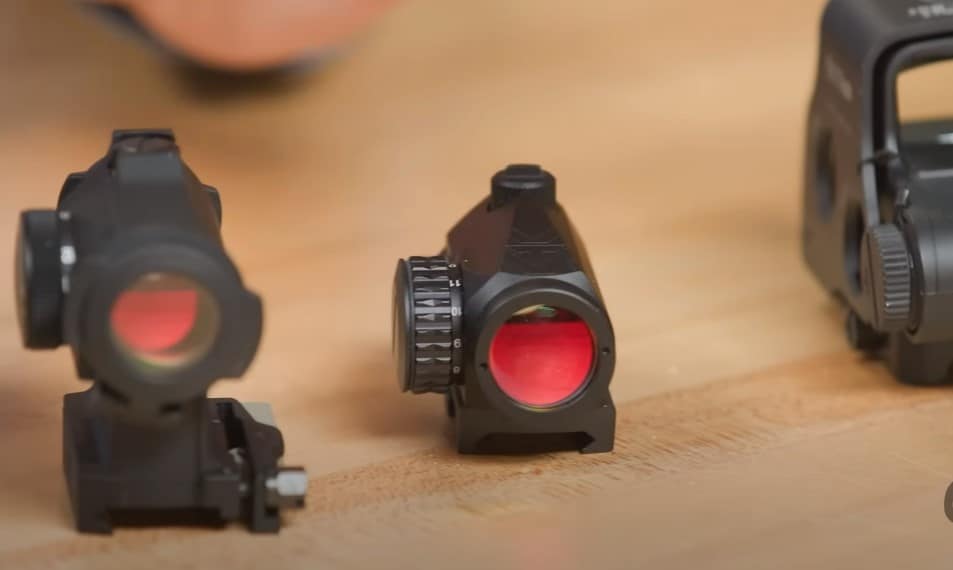Red Dot Or Holographic Sight For AR-15?

The AR-15 is the most popular rifle in the United States. In reality, this makes plenty of sense; the rifle is lightweight, accurate, affordable, and easy to shoot.
The carbine variants of these rifles are especially light and handy and dominate the military and police market.
What we saw as the rifle was adopted by more and more military forces and police departments was the adoption of optics designed for close-quarters combat.
These optics provided to military and law enforcement typically came from either Aimpoint or Eotech; these optics grew rapidly in popularity and have become mainstays on rifles in police, military, and civilian hands.
The main difference between the two most popular AR-15 optics is that one is known as a holographic sight, and the other is a red dot sight.
Both are reflexive sights designed for close-range combat. However, the question comes up of which is actually better for the AR 15.
Red Dots vs. Holographic Sights For AR-15
You’ve likely heard a lot about red dots or holographic sights. But, if you’re new to firearms and equipment, you might wonder, “what’s the difference between holograms and red dots?” Then there’s also the question of which is the most appropriate for you.
All About Holographic Sights
Holographic sights are usually in a semi-square shape design, but they can also vary to a rounder style. This square design lacks the overall tube style of a standard optic and offers a much wider field of view.
When using the Bindon aiming concept, the actual rectangular window tends to disappear and simply superimposes the reticle onto your vision. This gives you an enhanced peripheral vision and is almost completely unobstructed.
Holographics use a laser-transmitted hologram to give the user a solid reticle. The use of a laser-transmitted hologram gives the user a slightly more versatile option.
They also solve a problem that for close-range combat, an overly complicated reticle is discouraged, but for longer ranges, the single dot is not the best choice too.
That is why Eotech offers several options for reticles, where a red dot is just a red dot. The basic AR 15 holographic reticle allows ease of use from 2 to 200 yards without adjustments to the reticle.
This is because the reticle uses a 68 MOA circle for close range and a small 1 MOA dot for longer ranges, out to 200 meters. So, when you combine a holographic optic with a magnifier you can turn a 1x CQB optic into a half decent 3 power scope.
Generally, holographic optics are also better suited for being used with magnification. The magnifier sits behind the optic, and when in use, the 1 MOA dot will not expand, but the target will appear three times as large. This makes precision shooting much easier when using a magnifier.
All About Red Dot Sights
Red dots vary greatly in size and style. These sights can be standard tube-shaped designs like the Aimpoint Comp M4, or a micro-optic, with a square-shaped window like the Trijicon RMR.
Red dot designs are much more popular than Holographic sights due to their affordability and simplicity. A red dot can essentially be built much smaller than holographic sights and can act as a backup sight to a main magnified optic.
An AR 15 with a mounted Leupold could attach a red dot on an offset mount and have a backup optic in play for close-range shooting. In addition, because of their simplicity, red dot optics have extremely long battery life.
The Aimpoint models can typically run for five years off a single battery. However, the holographic reticle is more complicated and burns through battery much faster, with Eotechs lasting roughly a thousand hours.
With a good red dot, you’d never have to turn it off and change the battery less than once per year. A red dot might be for you if you want an optic for your AR 15 that you plug, play, and forget about.
Like the classic Aimpoint models, the tube-shaped red dots are more durable. If you are a brush hunter, then the red dot’s ability to shrug off the elements will probably match your AR.
Red dots tend to be more waterproof, better sealed, and capable of being submerged much deeper than any holographic optic.
As shown with Eotech’s optics, holographic sights can shift in point of impact under intense temperatures, which isn’t the case with red dots. Overall, their simple nature makes them much tougher when you have two comparable models.
Difference In Acquisition Speed
Holographic sights and red dots are both much faster than traditional iron sights. The dot is focused on your eyeball with red dots, so the focal distance at sight is the same as with holographic sights.
Choosing between something close to sight (red dot) and your target can slow you down if your eye focuses on both. This is because holographic sights superimpose your target.
Furthermore, the Speed Ring reticle makes it easier for quick closeup shots, while the 1 MOA dot makes it easier for more accurate shots.
The field of view
A significant advantage of having an electronic sight is that both eyes can be opened at the same time. You will have to get behind the sight a little more if it has a small window, like on a pistol red dot.
There are also tubes such as Aimpoints and others and holographic ones that are rectangular in shape. Holographics win out, but there are also red dots that have a wide field of view.
Magnification
A magnifier can be mounted on either a red dot sight or a holographic sight, but not with the same efficiency. Humans can see the light as small as 1 MOA. However, the dot is very small (microns) with holographic technology.
Magnifying something tiny doesn’t change its size. In other words, it still appears as one MOA to us. Putting a magnifier in front of a holographic sight still shows 1 MOA, which is why you can use any magnifier.
Night Vision
There are holographic and red dot sights that are compatible with night vision. Night vision devices can be operated on dim settings without damage.
Color
It’s easy for the eyes to distinguish red dots and holographic sights because red is easy to see. There are now green versions of both, which are even easier to see.
As you move between different lights, such as clearing a first-floor room and then entering the basement, green isn’t as effective. As a competitor, I like green because it is easier to pick up, and there is nearly constant lighting outside.
Power
Holographic sights require lasers to power their holograms, while red dots use power-saving LEDs. This way, a couple of red dots can run for up to 50,000 hours on a single battery charge. In other words, you could leave it on for a long time.
A red dot sight offers a greater battery life than a holographic sight, which usually lasts between 500 and 1,000 hours.
Longevity
Aimpoint and EOTech are two of the top-of-the-line models in each category. The right optics can be purchased reasonably and remain operational in extreme temperatures, g-forces, and water depths. It is possible to find red dots rated only for airsoft at some lower prices.
Size
Is size important? Red dots are good if you’re looking for something small. Both handguns and rifles can be fitted with smaller options since the technology has become easier.
Currently, there are no tiny versions of holographic sights available, even though they aren’t huge.
Technology
How are holographic sights different from red dots technologically? In my mind, a red dot sight was characterized by a red dot reticle, whereas a holographic sight was characterized by a big ring and a small dot reticle.
There is much more complexity involved in holographic sights. For example, an LED emits a beam of light in a red dot and reflects it back to your eyes through the front glass coating.
On the other hand, holographic sight uses lasers and mirrors to send you a hologram (without using the front glass) that appears to be facing you.
Price
A complicated process comes at a higher price. If you’re looking for something more robust, I recommend something in the sub-$200 range.
Bottom Line
In terms of military and police accomplishments, the red dot does seem to be gaining the most ground. However, the holographic sight does offer a level of versatility the standard red dot cannot match.
This ultimately means the choice is up to you. If you want versatility and ease of use, go with a holographic sight. If you want simplicity and durability, go with the red dot.

